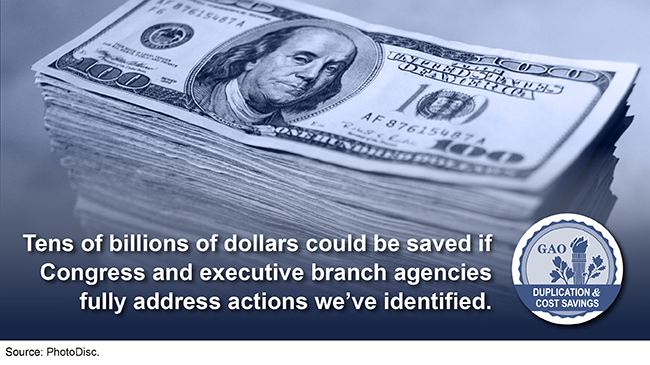2021 Annual Report: New Opportunities to Reduce Fragmentation, Overlap, and Duplication and Achieve Billions in Financial Benefits
Fast Facts
Each year GAO reports on federal programs with fragmented, overlapping, or duplicative goals or actions and ways to reduce costs or boost revenue. We identified 112 new actions that Congress and agencies could take to address these findings—e.g., changing how agencies buy goods and services to save money.
Agencies have made significant progress in addressing many of the over 1,100 actions we identified in the past decade. We estimate at least tens of billions of dollars in financial benefits have resulted since May 2020. Addressing remaining actions could save tens of billions more dollars. We'll update total financial benefits in fall 2021.

Highlights
What GAO Found
GAO identified 112 new actions for Congress or executive branch agencies to improve the efficiency and effectiveness of government. For example:
- The Office of Management and Budget should improve how agencies buy common goods and services—such as medical supplies and computers—by addressing data management challenges and establishing performance metrics to help save the federal government billions of dollars over the next 5 years, as well as potentially eliminate duplicative contracts.
- The Internal Revenue Service (IRS) could enhance third-party information reporting to increase compliance with tax laws and raise revenue. GAO has also previously suggested (1) providing IRS with authority—with appropriate safeguards—to correct math errors and to correct errors in cases where information provided by the taxpayer does not match information in government databases and (2) establishing requirements for paid tax return preparers to help improve the accuracy of tax returns they prepare. These actions could help reduce the substantial tax gap and increase revenues.
- The National Nuclear Security Administration could implement cost savings programs to operate more effectively at its nuclear laboratory and production sites to potentially save hundreds of millions of dollars over approximately a 5-year period.
- The Department of Defense's payments to privatized housing projects have lessened the financial effects of the housing allowance rate reductions for these projects, but revising the calculation for these payments could potentially result in millions of dollars of savings.
- Federal agencies could improve coordination of fragmented cybersecurity requirements and related assessment programs for state agencies, potentially minimizing the burden on states and saving millions of dollars in associated federal and state costs.
- The Department of Health and Human Services (HHS) could improve coordination of its infectious disease modeling efforts to better identify any duplication and overlap among agencies, which could help them to better plan for and more efficiently respond to disease outbreaks.
From 2011 to 2021, GAO has identified more than 1,100 actions to reduce costs, increase revenues, and improve agencies' operating effectiveness. GAO's last report in May 2020 said progress made in addressing many of the actions identified from 2011 to 2019 had resulted in approximately $429 billion in financial benefits, including $393 billion that accrued through 2019 and $36 billion that was projected to accrue in future years.
Since May 2020, at least tens of billions of dollars in additional financial benefits have been achieved. For example, based on GAO's updates for spring 2021, HHS's changes to spending limit determinations for Medicaid demonstration waivers further reduced federal spending by about $30 billion in 2019.
GAO estimates that tens of billions of additional dollars could be saved should Congress and executive branch agencies fully address open actions, including those that have potential financial benefits of $1 billion or more.
Why GAO Did This Study
The federal government has made an unprecedented financial response to the COVID-19 pandemic. Once the pandemic recedes and the economy substantially recovers, Congress and the administration will need to develop and swiftly implement an approach to place the government on a sustainable long-term fiscal path.
In the short term, opportunities exist for achieving billions of dollars in financial savings and improving the efficiency and effectiveness of a wide range of federal programs in other areas.
GAO has responded with annual reports to a statutory provision for it to identify and report on federal programs, agencies, offices, and initiatives—either within departments or government-wide—that have duplicative goals or activities. GAO also identifies areas that are fragmented or overlapping, as well as additional opportunities to achieve cost savings or enhance revenue collection.
This report discusses the new areas identified in GAO's 2021 annual report—the 11th in this series—and examples of open actions recommended to Congress or executive branch agencies with potential financial benefits of $1 billion or more.
To identify what actions exist to address these issues, GAO reviewed and updated select prior work, including matters for congressional consideration and recommendations for executive action.
For more information, contact Jessica Lucas-Judy at (202) 512-6806 or lucasjudyj@gao.gov or Michelle Sager at (202) 512-6806 or sagerm@gao.gov.
